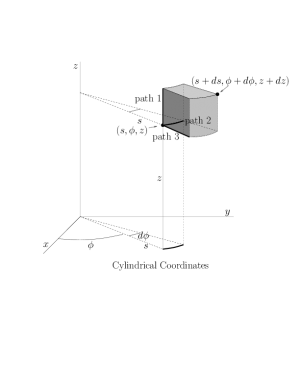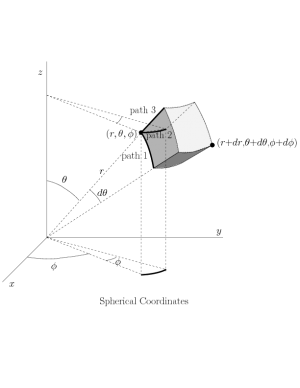Wrap-Up: Scalar Surface and Volume Elements
Evaluating surface integrals in other coordinate systems involves the same idea as double integrals in rectangular coordiantes: chop and add. The difference is in the way one chops.
In polar coordinates, one chops a region into pie shaped regions using radial lines and circles. These lines are orthogonal to each other, so that a small enough piece is nearly rectangular, which means that its area is just its length times its width. As discussed in § {Double Integrals in Polar Coordinates}, a little thought shows that a radial side has length $dr$, but a circular side has length $r\,d\phi$ — not merely $d\phi$, which has the wrong units. Thus, in polar coordinates, \begin{equation} dA = r\,dr\,d\phi \end{equation}
The same argument shows that a small piece of the surface of a cylinder has area given by \begin{equation} dA = r\,d\phi\,dz \end{equation} since the two sides of the rectangle have lengths $r\,d\phi$ and $dz$. This construction is illustrated in the first figure below (which can also be used for polar coordinates if one ignores the vertical path).
Spherical coordinates can be handled similarly. The two sides are parts of lines of longitude and latitude. Segments along lines of longitude (“vertical”) have length $r\,d\theta$, but segments along lines of latitude (“horizontal”) have length $r\sin\theta\,d\phi$ — the radius of the circle depends on the latitude, hence the extra factor, which turns out to be $\sin\theta$. Thus, on the surface of a sphere we have \begin{equation} dA = r^2\sin\theta\,d\theta\,d\phi \end{equation} This construction is illustrated in the second figure below.
Similar arguments apply to triple integrals, as discussed in § {Triple Integrals in Cylindrical and Spherical Coordinates}

